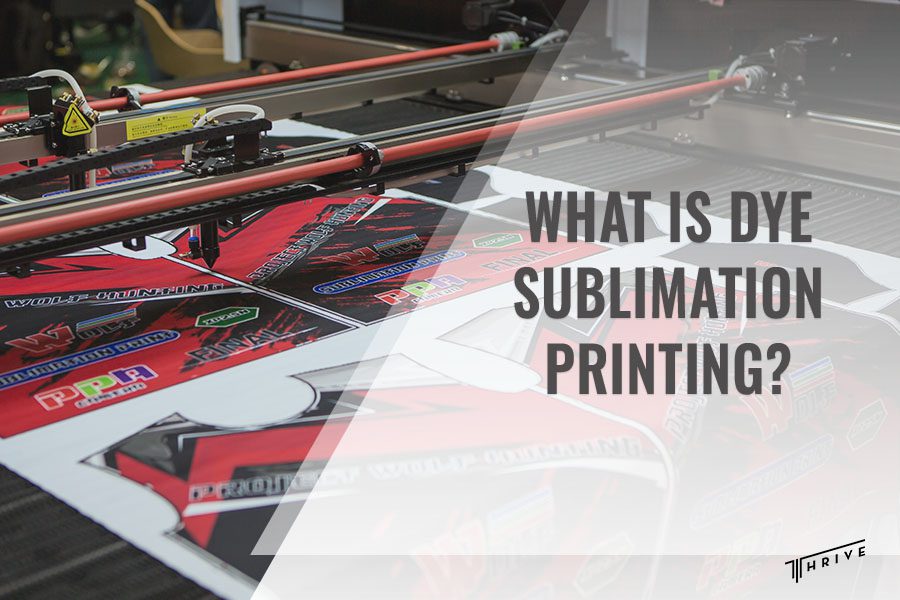The personalization sector makes use of various printing techniques – digital printing, flexography, offset printing, etc. You may have heard about sublimation being among the best methods regarding efficiency, cost-effectiveness, and color accuracy. But what is dye sublimation printing, and how can it benefit you?
Below, we’ll explain the process of dye sublimation, go over the sublimation essentials, and provide some handy tips and tricks for sublimating different blanks.
What Is Dye Sublimation Printing?
Dye sublimation, also called heat transfer printing, is the process of applying high heat pressure to print a design to a base material. It’s one of the most effective printing methods for producing vibrant, colorful designs.
Dye sublimation only works on one base material – polyester. So, if the fabric is a blend with a low percentage of polyester, the print won’t come out as intended. In such cases, the top contract screen printers are a better option if printing on 100% cotton, for example.
But then, how come we see all these printed mugs and glasses using sublimation? The key is to make your desired base material sublimation-friendly. This can be done by spraying the object with polyester coating or printing the design on printable sublimation heat transfer vinyl.
Why choose dye sublimation printing?
There’s a reason why dye sublimation is so popular. This printing method’s main advantage is that it sinks into and blends with the material. This means that you won’t be able to feel it by touching the garment.
Sublimation prints are also very durable, so they’ll never crack, regardless of how long you’ve had the garment.
Besides its versatility and durability, there are many additional benefits to dye sublimation printing:
- Allows printing on rigid surfaces
- Easily operated
- Unlimited color range when it comes to the design
- Acceptable learning curve
- Suitable for smaller businesses that want to design everything in-house
How does dye sublimation work? Let’s explore the step-by-step process below.
Step-By-Step Dye Sublimation
What is dye sublimation printing and how does it work? Dye sublimation is a straightforward printing technique. First, you’ll need to purchase some essentials like:
- Sublimation printer
- Sublimation paper or printable sublimation HTV
- Sublimation ink
- Heat press
- Pressing mats
- Paper for protection (butcher, cardstock, or white copy paper)
- Heat-resistant tape to keep prints in place and prevent ghosting
- Heat-resistant gloves for protection
- Base material, also called blank or substrate
And here are the basic steps for a sublimation print:
- Print a design on sublimation paper or printable sublimation HTV.
- Take the paper and place it in the heat press.
- Heat press the design on an item of your choice.
How a dye sublimation printer works
So, how does a dye sublimation printer work? It’s as simple as using your regular house printer, except you’ll need special sublimation ink on special sublimation paper or HTV.
You may face size issues when printing an unusually large design. To accommodate designs of both small and large sizes, either get a large-format printer or tape multiple papers together.
Some printers have their own printing dye, and others require you to put ink. If you’re using an EcoTank printer, you can get autofill sublimation ink bottles for easier refills.
Keep in mind that you don’t need a sublimation printer to make sublimation prints. You can also convert an inkjet printer into a sublimation printer by replacing the inkjet ink with sublimation ink. This will save you significant money if you already have such a printer at home.
Types of Dye Sublimation Presses
There are many types of sublimation presses: easy press, traditional heat press, cricut auto press, etc. For unusually shaped surfaces, there are specialized printers like a hat press, mug press, and tumbler press; you can even use a convection oven with silicone sleeves and bands.
Keep in mind that you cannot use a household iron, for example, because sublimation ink activates at 350°F. Some people like to use a heat gun, but it just doesn’t work as well as a professional heat press.
How Long You Should Sublimate Different Blanks
It’s completely normal not to know where to start when sublimating for the first time. The different heat settings and times for sublimation can overwhelm first-time printers. But don’t worry; we’ve included some basic info on how to sublimate according to your blank.
Let’s say you want to sublimate a ceramic mug. The recommended press time is 150-210 seconds at 350-400°F. Don’t forget to cool the mug afterward to make sure it doesn’t remain hot for too long.
The suggested press time is 45-55 seconds at 380-390°F if you decide to sublimate clothing. To make sure your garment comes out perfect, get a heat press pillow placed inside a non-stick casing. The pillow helps distribute the heat evenly across the garment, ensuring a solid print. Plus, you’ll have no trouble printing over buttons, logos that stick out, and zippers when using a heat press pillow.
Glass is a rather tricky material, so you’re not alone if you’re scared of printing on glass. However, you won’t have any problems as long as you’re careful. We suggest a press time of 180-240 seconds at 360-400°F. Avoid adding too much pressure to the glass object, or you’ll shatter it.
For all other materials, stick to the average heat temperature we recommended above. With time, you’ll easily be able to tell what works and what doesn’t.
How to Choose the Right Colors for Sublimation
There are quite a lot of color restrictions when it comes to sublimation. For example, you cannot print white using dye sublimation, as it’ll turn into the color of the base material.
Dye sublimation prints also don’t transfer nicely on very dark garments, especially if they’re darker than the print. So, avoid black T-shirts and stick to lighter shades such as the ones made up of dirty white, mint, gray, peach, and cream.
Your design will stick out the most on a white garment. This is because the print is absorbed into the garment, and putting vibrant colors on white makes them stand out.
What Is Dye Sublimation Printing Used For?
Contrary to popular belief, you don’t have to do sublimation printing only on 100% polyester items. You can always buy a sublimation spray, which will cover the surface and make it sublimation-friendly.
You can also sublimate laminated items and even T-shirts with a high polyester-to-cotton ratio. Alternatively, you can use glitter, flock, glow-in-the-dark, or holographic HTV instead of a polyester spray to print on items like mugs and tumblers.
There are so many fun sublimation projects you can take on, from cute themed socks to garden flower spinners.
Cute sublimation projects you can try
So, what is dye sublimation printing best used for? Since you now know you can sublimate everything from wood to glass, it’s time to get creative. You could try sublimating a satin pillowcase or some themed socks. Other ideas include:
- Mouse pad
- Cutting board
- Phone case
- Pencil case
- Drink coasters
- Baby onesie
- Christmas decorations
- Towels, and much more
Using a Printer Profile for Color Accuracy in Dye Sublimation
For your prints to come out looking spotless, you need to pay attention to the design process as much as the printing process. After designing your logo, lettering, or picture, you have to ensure the colors you’ve chosen will come out as intended. You can do this using a printer profile, also called an ICC profile.
A printer or ICC profile gives your computer a set of data on how your printer reproduces colors. This allows you to adjust your computer and printer settings for an optimal result.
You can automatically create your profile via the printer software or by using a third-party tool like MonacoPROFILER.
There are many benefits to using a printer profile:
- Preventing color inaccuracy
- Ensuring accurate prints
- Creating bold color combinations
- Reducing color fading
- Producing designs of the highest quality
Conclusion
What is dye sublimation printing? Dye sublimation is a digital printing technology used for transferring designs on polyester material using specialized sublimation ink and printer.
The important thing to know about this printing method is that it works best on polyester. However, you can print on any material you like as long as you make its surface suitable for sublimation or use HTV for image transfer.
With dye sublimation, you can fully customize your bed sheets, wall decals, and even clothing. Don’t be afraid to experiment, and rest assured your finished designs will have a brilliant color!
For all your other printing needs, contact us at Thrive Screen Printing.

Robert Fisher is the founder and CEO of Thrive Screen Printing and brings extensive experience in the screen printing and fulfillment industry.


